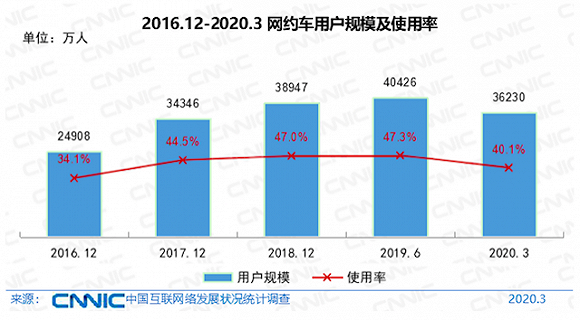They all aimed at a new direction-the same city logistics.
Editor’s note: This article is reprinted from interface News , Author: Ke Xiaobin, Edit: Wen Shuqi, reproduced with permission.
The online car-hailing industry chain is undergoing an industry migration.
In October last year, a relatively large leasing company in Ningbo terminated its cooperation with Didi for nearly five years and withdrew from the car-hailing market. Also in the South China market, a leasing company with thousands of vehicles is also preparing to make a U-turn. In Nanjing, many leasing companies have begun to turn. They all aimed at a new direction-the same city logistics.
This is no accident. As early as 2018, after Didi’s torrent strategy landed, Didi’s intention to remove the “lease” began to appear. Didi then launched the small orange car service, further eroding the market that originally belonged to the leasing company.
Affected by the epidemic, many leasing company bosses all said that before March, the orders of drivers decreased by about 60%, but now, only 60% before the outbreak has been restored. The direct consequence of the lower income of drivers is ——The emergence of the car retreat has further increased the pressure on the capital of the leasing company. The black swan has made the leasing company that has been struggling harder.
In addition, since the beginning of this year, large online car-hailing platforms have also begun to deploy logistics in the same city. In March, Didi launched the errand business, and then in April, it was ready to enter the same city freight; at the same time, another online car-hailing platform, Hello Travel, also tested the same city logistics, focusing on small items distribution; Cao Cao travel was also launched last year “Cao Cao helps”, the same city logistics has become their new battlefield.
This bottom-up transformation is not a one-off event. According to the 45th report released by the China Internet Network Information Center, the growth of the number of ride-hailing users has slowed. At the same time, the owner of the aforementioned Ningbo Didi cooperation supplier said that compared with before the outbreak, their demand for logistics services in the same city increased by nearly 30%.
For the online car-hailing supply chain, the transformation into logistics has become a “life-saving straw”. For the platform of Didi, when the main business online car-hailing is greatly affected, it will launch the same city logistics. Become another new story they find.
Indeed, this is a large enough market. According to third-party data platform iResearch, the same city logistics is expected to maintain a growth rate of 5-7% in the next 3-5 years. Break through trillions.
However, after all, giving and giving are completely different.Scenes. The most direct challenge for online ride-hailing platforms to become logistics is how to lay channels to get the B (business) market as much as possible. Another dimension is that in this market, there are already strong brands such as Lala and Kuaidu taxi. Whether it can break through is also a test.
In any case, in the case of the overall decline in online car-hailing orders and the continued impact of the epidemic, the layout of logistics is also a way of self-help.
Is the online car reaching the ceiling?
In recent years, the number of ride-hailing users is still growing, but the growth rate has slowed down significantly.
On April 28 this year, China Internet Network Information Center released the 45th “Statistical Report on the Development of China Internet Network” (hereinafter referred to as “Report”). “Report” data shows that after 2018, the scale of my country’s ride-hailing users has increased, and user usage has slowed down. Among them, compared with June 2019 and December 2018, the user size has only increased by 0.3%, and compared with the same period in 2017 in December 2018, this data is 2.5%. In addition, affected by the epidemic, as of March 2020, the number of Internet and car users was 360 million, a decline of about 7%.

At the same time, the “Report” also shows that at present, more than 140 ride-hailing platform companies in China have obtained business licenses, and more than 1.5 million legal ride-hailing drivers nationwide have completed online ride-hailing orders on average. Over 20 million orders.
Before the epidemic, in November 2019, the Shenzhen Municipal Transportation Bureau released the operating data of the Shenzhen car-hailing industry in the third quarter of 2019. The data shows that in the third quarter of last year, the average daily car-hailing order of Shenzhen City was about 7.2 orders, down 22.5% month-on-month; the average daily mileage was about 69.06 kilometers, down 17.8% month-on-month; the average daily passenger mileage was about 59.94 kilometers , The chain fell by 18.1%, and the average daily operating amount per car order was about 244.43 yuan, down 17.5% from the previous month.
The former owner of South China Market Leasing Company told the interface reporter that last year, in addition to the previous trips of Didi, Meituan, Hello, Cao Cao, in his city, new players have also entered Guangzhou Automobile ’s Ruqi Travel 1. Newly built car forces have Peng travel. “The market size is limited for a period of time. After various players come in, the number of individual drivers has seriously declined, and there are only about 10 orders. The monthly income is less than 2,000 yuan, which leads to a large number of online car drivers to choose to return. . “
This year, Didi launched delivery centers in several cities, clearly allocating to suppliers